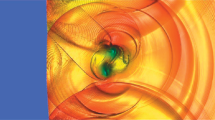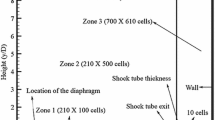Abstract
Numerical simulation results of a convecting shielded vortex interacting with a normal shock using a compact scheme in the convecting upwind and split pressure framework are presented. We explore the parameter space spanned by vortex Mach number and incident Mach number to look for combinations of the parameters which lead to vortex breakdown. The incident and vortex Mach numbers covered are on the higher side, where relatively less information is available. It is well known that for a weak shock, the vortex retains its original shape and for stronger shocks it breaks down. In-between these two extremes, there is a region where the vortex neither retains its original shape nor does it break into small pieces. We determine the vortex breakdown and transition regions that have not so far been reported in shock–vortex interaction studies. A number of cases have been studied, and a vortex breakdown criterion for the cases considered is proposed.











Similar content being viewed by others
Data availability
Data will be made available on reasonable request.
References
Cutler, A.D., Levey, B.S.: Vortex breakdown in a supersonic jet. 22nd Fluid Dynamics, Plasma Dynamics and Lasers Conference, Honolulu, HI, AIAA Paper 1991–1815 (1991). https://doi.org/10.2514/6.1991-1815
Nelson, R.C., Pelletier, A.: The unsteady aerodynamics of slender wings and aircraft undergoing large amplitude maneuvers. Prog. Aerosp. Sci. 39, 185–248 (2003). https://doi.org/10.1016/S0376-0421(02)00088-X
Rault, A., Chiavassa, G., Donat, R.: Shock-vortex interactions at high Mach numbers. J. Sci. Comput. 19(1–3), 347–371 (2003). https://doi.org/10.1023/A:1025316311633
Inoue, O., Hattori, Y.: Sound generation by shock–vortex interactions. J. Fluid Mech. 380, 81–116 (1999). https://doi.org/10.1017/S0022112098003565
Meadows, K.R., Kumar, A., Hussain, M.Y.: Computational study on the interaction between a vortex and a shock wave. AIAA J. 29(2), 174–179 (1991). https://doi.org/10.2514/3.59916
Smart, M.K., Kalkhoran, I.M., Popovic, S.: Some aspects of streamwise vortex behavior during oblique shock wave/vortex interaction. Shock Waves 8, 243–255 (1998). https://doi.org/10.1007/s001930050117
Hollingsworth, M.A., Richards, E.J.: A Schlieren study of the interaction between a vortex and a shock wave in a shock tube. Br. Aeronaut. Res. Counc. 17, 985 (1955). http://cir.nii.ac.jp/crid/1573387448929137920
Dosanjh, D.S., Weeks, T.M.: Interaction of a starting vortex as well as a vortex street with a traveling shock wave. AIAA J. 3, 216–223 (1965). https://doi.org/10.2514/3.2833
Naumann, A., Hermanns, E.: On the interaction between a shock wave and a vortex field. AGARD Conference Proceedings (1973)
Ribner, H.S.: The sound generated by interaction of a single vortex with a shock wave. University of Toronto, Institute of Aerospace Studies (UTIA) Report No. 61 (1959)
Ribner, H.S.: Cylindrical sound wave generated by shock–vortex interaction. AIAA J. 23, 1708–1715 (1985). https://doi.org/10.2514/3.9155
Dosanjh, D.S., Weeks, T.M.: Sound generation by shock–vortex interaction. AIAA J. 5, 660–669 (1967). https://doi.org/10.2514/3.4045
Ting, L.: Transmission of singularities through a shock wave and the sound generation. Phys. Fluids 17(1518), 1–21 (1974). https://doi.org/10.1063/1.1694928
Zhang, S., Jiang, S., Zhang, Y.T., Shu, C.W.: The mechanism of sound generation in the interaction between a shock wave and two counter-rotating vortices. Phys. Fluids 21(076101), 1–9 (2009). https://doi.org/10.1063/1.3176473
Pirozzoli, S.: Numerical methods for high-speed flows. Annu. Rev. Fluid Mech. 43, 163–194 (2010). https://doi.org/10.1146/annurev-fluid-122109-160718
Tatsumi, S., Martinelli, L., Jameson, A.: Flux-limited schemes for the compressible Navier–Stokes equations. AIAA J. 33(2), 252–261 (1995). https://doi.org/10.2514/3.12422
Kundu, A., De, S.: Application of compact scheme in the CUSP framework for strong shock–vortex interaction. Comput. Fluids 126, 192–204 (2016). https://doi.org/10.1016/j.compfluid.2015.11.018
Guo-Hua, T., Xiang-Jiang, Y.: A characteristic-based shock-capturing scheme for hyperbolic problems. J. Comput. Phys. 225, 2083–2097 (2007). https://doi.org/10.1016/j.jcp.2007.03.007
Kundu, A., De, S.: Navier–Stokes simulation of shock–heavy bubble interaction: comparison of upwind and WENO schemes. Comput. Fluids 157, 131–145 (2017). https://doi.org/10.1016/j.compfluid.2017.08.025
Chang, K.S., Barik, H., Chang, S.M.: The shock–vortex interaction patterns affected by vortex flow regime and vortex models. Shock Waves 19, 349–360 (2009). https://doi.org/10.1007/s00193-009-0210-1
Pirozzoli, S.: Conservative hybrid compact-WENO schemes for shock–turbulence interaction. J. Comput. Phys. 178, 81–117 (2002). https://doi.org/10.1006/jcph.2002.7021
Lele, S.K.: Compact finite difference schemes with spectral-like resolution. J. Comput. Phys. 103, 16–42 (1992). https://doi.org/10.1016/0021-9991(92)90324-R
Carpenter, M.H., Kennedy, C.A.: Fourth-order 2N-storage Runge–Kutta schemes. NASA TM 109112 (1994). https://ntrs.nasa.gov/citations/19940028444
Richardson, L.F.: The approximate arithmetical solution by finite differences of physical problems involving differential equations, with an application to the stresses in a masonry dam. Philos. Trans. R. Soc. Lond. 210, 307–357 (1911). https://doi.org/10.1098/rsta.1911.0009
Roache, P.J.: Perspective: a method for uniform reporting of grid refinement studies. J. Fluids Eng. 116, 405–413 (1994). https://doi.org/10.1115/1.2910291
Zhou, G., Xu, K., Liu, F.: Grid-converged solution and analysis of the unsteady viscous flow in a two-dimensional shock tube. Phys. Fluids 30(016102), 1–21 (2018). https://doi.org/10.1063/1.4998300
Kundu, A., De, S., Thangadurai, M., Dora, C.L., Das, D.: Numerical visualization of shock tube-generated vortex–wall interaction using a fifth-order upwind scheme. J. Vis. 19, 667–678 (2016). https://doi.org/10.1007/s12650-016-0362-x
Samtaney, R., Pullin, D.I.: On initial-value and self-similar solutions of the compressible Euler equations. Phys. Fluids 8, 2650 (1996). https://doi.org/10.1063/1.869050
Ellzey, J.L., Henneke, M.R., Picone, J.M., Oran, E.S.: The interaction of a shock with a vortex: shock distortion and the production of acoustic waves. Phys. Fluids 7, 172–184 (1995). https://doi.org/10.1063/1.868738
Fürst, J., Angot, P., Debieve, J. F., Kozel, K.: Two and three-dimensional applications of TVD and ENO schemes. Numerical Modelling in Continuum Mechanics, 3rd Summer Conference in Praha, MATFIZPRESS Charles Univ., 1, 103–111 (1997)
Orlandi, P., van Heijst, G.F.: Numerical simulation of tripolar vortices in 2D flow. Fluid Dyn. Res. 9, 179–206 (1992). https://doi.org/10.1016/0169-5983(92)90004-G
Paireau, O., Tabeling, P., Legras, B.: A vortex subjected to a shear: an experimental study. J. Fluid Mech. 351, 1–16 (1997). https://doi.org/10.1017/S0022112097006915
Sun, M., Takayama, K.: A note on numerical simulation of vortical structures in shock diffraction. Shock Waves 13, 25–32 (2003). https://doi.org/10.1007/s00193-003-0195-0
Rubidge, S., Skews, B.: Shear-layer instability in the Mach reflection of shock waves. Shock Waves 24, 479–488 (2014). https://doi.org/10.1007/s00193-014-0515-6
Chen, Z., Yi, S.H., Tian, L.F., He, L., Zhu, Y.Z.: Flow visualization of supersonic laminar flow over a backward-facing step via NPLS. Shock Waves 23, 299–306 (2013). https://doi.org/10.1007/s00193-012-0378-7
Johnsen, E., Larson, J., Bhagatwala, A.V., Cabot, W.H., Moin, P., Olson, B.J., Rawat, P.S., Shankar, S.K., Sjögreenc, B., Yee, H.C., Zhong, X., Lele, S.K.: Assessment of high-resolution methods for numerical simulations of compressible turbulence with shock waves. J. Comput. Phys. 229, 1213–1237 (2010). https://doi.org/10.1016/j.jcp.2009.10.028
Kundu, A., Thangadurai, M., Biswas, G.: Investigation on shear layer instabilities and generation of vortices during shock wave and boundary layer interaction. Comput. Fluids 224, 104966 (2021). https://doi.org/10.1016/j.compfluid.2021.104966
Kevlahan, N.K.R.: The vorticity jump across a shock in a non-uniform flow. J. Fluid Mech. 341, 371–384 (1997). https://doi.org/10.1017/S0022112097005752
Thakare, P., Nair, V., Sinha, K.: A weakly nonlinear framework to study shock–vorticity interaction. J. Fluid Mech. 933, A48 (2022). https://doi.org/10.1017/jfm.2021.1076
Kevlahan, N.K.R.: The propagation of weak shocks in non-uniform flows. J. Fluid Mech. 327, 161–197 (1996). https://doi.org/10.1017/S0022112096008506
Jeong, J., Hussain, F.: On the identification of a vortex. J. Fluid Mech. 285, 69–94 (1995). https://doi.org/10.1017/S0022112095000462
Halder, P., De, S., Sinhamahapatra, K.P., Singh, N.: Numerical simulation of shock–vortex interaction in Schardin’s problem. Shock Waves 23, 495–504 (2013). https://doi.org/10.1007/s00193-013-0448-5
Colonius, T., Lele, S.K.: Computational aeroacoustics: progress on nonlinear problems of sound generation. Prog. Aerosp. Sci. 40, 345–416 (2004). https://doi.org/10.1016/j.paerosci.2004.09.001
Sinha, K.: Enstrophy in shock/homogeneous turbulence interaction. J. Fluid Mech. 707, 74–110 (2012). https://doi.org/10.1017/jfm.2012.265
Acknowledgements
The author thanks Sudipta De, former Principal Scientist at CSIR-CMERI, for his enormous contribution in developing the inhouse compressible-flow solver. The author gratefully acknowledges help and support from Anupam Sinha for providing the High-Performance Computing Facility of CSIR-CMERI.
Author information
Authors and Affiliations
Corresponding author
Additional information
Communicated by E. Timofeev.
Publisher's Note
Springer Nature remains neutral with regard to jurisdictional claims in published maps and institutional affiliations.
Rights and permissions
Springer Nature or its licensor (e.g. a society or other partner) holds exclusive rights to this article under a publishing agreement with the author(s) or other rightsholder(s); author self-archiving of the accepted manuscript version of this article is solely governed by the terms of such publishing agreement and applicable law.
About this article
Cite this article
Kundu, A. Breakdown regime of a shielded vortex interacting with a standing normal shock: a numerical study. Shock Waves 34, 21–36 (2024). https://doi.org/10.1007/s00193-024-01163-8
Received:
Revised:
Accepted:
Published:
Issue Date:
DOI: https://doi.org/10.1007/s00193-024-01163-8




